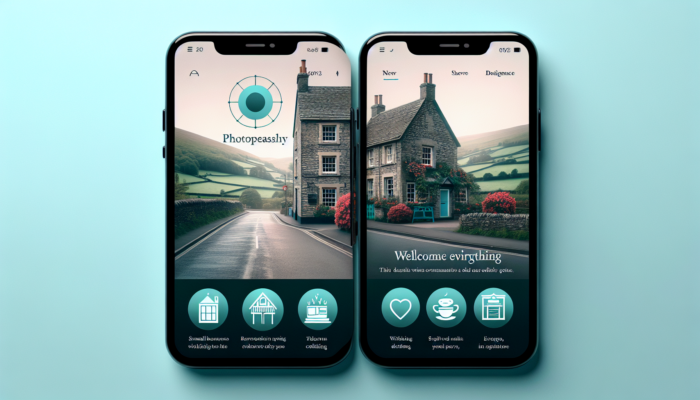Serving Backlinks and surrounding areas for over 25 years.
Trusted by local business for reliable website design, SEO services and Digital Marketing in Somerset, Dorset, Devon, Wiltshire and Gloucestershire. 30 years of online marketing experience across the world.
Table of Contents
ToggleMaximising the Potential of Branded Content for Effective Backlink Strategies
Defining Branded Content and Its Purpose

Utilise Branded Content Campaigns for Backlinks: Branded content serves as a powerful marketing tool that skillfully integrates a brand's narrative into engaging materials without directly promoting specific products or services. This approach fosters a meaningful connection between consumers and brands while subtly conveying the brand's values. It can manifest in various formats, including articles, videos, podcasts, and infographics. By emphasising storytelling and creativity, branded content effectively captivates audiences, prompting them to engage with the material. A significant objective of producing such content is to acquire valuable backlinks, as esteemed websites and blogs are more inclined to link to content that resonates with their audiences and delivers genuine value. This is where the concept of using branded content campaigns for backlinks truly excels, as it not only elevates a brand's profile but also significantly enhances SEO efforts through strategic link-building.
Got Time to Listen?
Exploring the Multifaceted Benefits of Branded Content
The advantages of branded content are abundant and encompass various aspects of marketing. Firstly, it significantly boosts brand awareness. When executed with precision, branded content seizes the attention of its target audience, facilitating brand recognition. This heightened recognition can lead to increased website traffic and improved search engine rankings. Secondly, branded content can have a profound impact on SEO. High-quality content that delivers value is more likely to be shared and linked to, resulting in a natural backlink profile that enhances a website's authority and credibility. Additionally, when reputable sources link to your content, it elevates your credibility within your industry, fostering a trusting relationship with your audience.
Another pivotal benefit lies in the potential for heightened engagement. Audiences are more inclined to share content that is entertaining, informative, or emotionally resonant. Such sharing not only amplifies visibility but also opens pathways for additional backlinks, further bolstering traffic and improving overall SEO efforts. While traditional advertising often disrupts the consumer experience, branded content immerses the audience in a narrative they choose to engage with, leading to a more favourable brand perception.
Ultimately, brands that utilise branded content campaigns for backlinks can expect improvements in organic reach, stronger audience relationships, and increased online visibility.
Ensuring Content Aligns with Core Brand Values
Creating branded content transcends merely generating links; it must authentically embody the brand's core values. Authenticity is the bedrock of successful branded content. When content aligns with a brand's vision and mission, it resonates more deeply with audiences, fostering greater trust. For instance, a brand committed to sustainability should produce content that showcases eco-friendly practices or narratives around environmental impact. This alignment not only reinforces the brand's message but also enhances the content's shareability, thereby increasing the likelihood of acquiring quality backlinks.
Moreover, maintaining consistency in messaging is paramount. If a brand advocates a particular ethos, all produced content should echo that ethos to cultivate a cohesive identity. This consistency aids in establishing brand loyalty and encourages reputable websites to link to your content, as they recognise the brand’s steadfast commitment to its values. Brands that effectively portray their ethos through engaging content often find themselves leading their industries, making them attractive partners for backlink opportunities.
When brands genuinely represent their core values through branded content campaigns, they not only attract quality links but also cultivate a loyal audience that champions their message.
Proven Strategies for Crafting Backlink-Worthy Branded Content

Creating content that naturally garners backlinks necessitates a strategic approach. First and foremost, prioritise quality over quantity. Exceptional, thoroughly researched content that delivers genuine value is far more likely to be shared and linked to than mediocre, hastily assembled materials. Leveraging comprehensive research and expert insights can transform ordinary articles into authoritative pieces that industry leaders are eager to reference.
Relevance is another critical element. Customising content to resonate with specific audiences ensures heightened engagement. For instance, a travel brand might develop a detailed guide on sustainable travel practices, appealing not only to eco-conscious travellers but also to various travel blogs that promote similar themes. By integrating unique insights or lesser-known facts, the content distinguishes itself and encourages others to link back for reference.
Furthermore, prioritising shareability is essential. Incorporate elements that promote sharing, such as captivating headlines, interactive features, or visually stunning graphics. Content that evokes strong emotions—be it humour, inspiration, or intrigue—has a higher likelihood of being shared widely, thus enhancing the potential for backlinks.
Ultimately, crafting branded content campaigns that focus on quality, relevance, and shareability for backlinks creates a virtuous cycle of engagement, visibility, and organic traffic growth.
Evaluating the Impact of Branded Content on Backlink Generation
Evaluating the impact of branded content on backlink generation is crucial for assessing the effectiveness of your SEO strategies. Analytics tools, such as Google Analytics and Ahrefs, offer insights into traffic sources, enabling brands to determine how much traffic is driven by backlinks earned through their content. Consistently monitoring these metrics allows brands to identify which pieces of content are most successful at attracting links and engagement.
Tracking the quality of backlinks is equally important. It’s not merely the number of links that matters, but the authority of the websites linking back to you. High-quality backlinks from reputable sources can significantly enhance organic rankings, whereas links from low-quality sites may negatively impact SEO efforts. Tools like Moz and SEMrush can help analyse the authority of backlink sources, providing a clearer picture of content effectiveness.
Engagement metrics, such as shares, comments, and time spent on the page, also serve as valuable indicators. High engagement often correlates with increased link-building opportunities, as content that captures attention is more likely to be referenced by others. By integrating these analytics, brands can refine their use of branded content campaigns to focus on producing content that resonates, engages, and earns valuable backlinks.
Crafting Compelling Branded Content
Understanding and Identifying Target Audiences

Gaining insight into your audience is the cornerstone of developing compelling branded content. Dedicate time to conducting comprehensive research and creating audience personas that accurately represent different segments of your target market. By delving into the needs, preferences, and pain points of your audience, you can tailor your content to resonate with their specific interests. For example, if your brand caters to tech enthusiasts, producing content that explores the latest innovations or reviews cutting-edge gadgets can foster deeper connections.
Moreover, audience engagement should be viewed as an ongoing process. Solicit feedback and monitor interactions with your content to evaluate what resonates best with your audience. Analytics tools can provide insights into what to refine in your content strategy. As you identify trending topics or emerging interests within your audience, you can adjust your content accordingly, ensuring it remains relevant and compelling.
In addition, consider the diversity of your audience. A global audience may have varying cultural references and preferences. Factoring in local contexts, such as popular trends or regional issues, can enhance relatability and encourage greater sharing. This relevance heightens the likelihood of earning backlinks, as diverse audiences may share your content across different platforms and networks.
By holistically understanding and engaging with your audience, brands can create impactful branded content that resonates deeply and drives backlinks, ultimately supporting the broader objectives of their content marketing strategies.
Developing Engaging and Relatable Storylines
Storytelling is a fundamental component of crafting compelling branded content. An engaging storyline not only captivates the audience but also motivates them to share and link back to the content. Start by identifying the core message or theme that aligns with your brand's values. This could range from showcasing customer success stories to exploring the product development journey. Construct narratives that evoke emotions, whether through humour, inspiration, or relatable challenges.
Incorporating characters or relatable personas in your stories can enhance engagement. Audiences are drawn to narratives that reflect their experiences or aspirations. By presenting real individuals facing challenges that your product or service can solve, you establish a connection that nurtures trust and encourages sharing. Consider incorporating case studies or testimonials into your narrative, as these real-life examples lend credibility and authenticity to your story.
Visual storytelling is another potent technique. Incorporating images, videos, or infographics can enrich your narrative and appeal to a broader audience. For instance, a video showcasing a brand's community involvement can prove far more impactful than a written article alone. When visual elements complement the narrative, they create a more immersive experience, enticing viewers to engage and share their thoughts.
In crafting engaging storylines, remember that your goal is not solely to inform but to inspire action. A well-told story can prompt readers to share your content or link back as a resource, driving valuable backlinks and enhancing your brand's online presence.
Utilising Multimedia Elements for Enhanced Engagement
Incorporating multimedia elements into branded content significantly amplifies its appeal and shareability. The human brain processes visuals far more rapidly than text, making images, videos, and infographics crucial for engaging audiences. This holds particularly true in today’s fast-paced digital landscape, where attention spans are shorter than ever. By integrating visually stimulating elements, brands can swiftly capture interest, increasing the likelihood of shares and backlinks.
Start by identifying the most suitable multimedia formats for your message. Infographics excel at breaking down complex data or presenting statistics in an easily digestible manner, making them highly shareable. Video content, on the other hand, offers opportunities for storytelling that is both engaging and dynamic. Tutorials, behind-the-scenes glimpses, or customer testimonials can resonate well and motivate audiences to link back to your original content.
Moreover, consider the role of social media platforms in disseminating your multimedia content. Each platform caters to different audience preferences, so tailor your multimedia approach accordingly. Short-form videos may perform well on TikTok or Instagram, while in-depth webinars may be more appropriate for LinkedIn. By crafting content that aligns with the specific nuances of each platform, you can maximise engagement and backlinks.
Additionally, ensure that your multimedia elements are optimised for SEO. Use alt tags for images and descriptive file names to enhance discoverability. Incorporating relevant keywords naturally within captions or descriptions can also improve the likelihood of your content being found and shared, ultimately bolstering your efforts to use branded content campaigns for backlinks.
Distributing Branded Content Effectively
Collaborating with Influencers for Enhanced Reach
Partnering with influencers can exponentially expand the reach of your branded content. Influencers possess established audiences that trust their opinions, rendering them powerful allies in amplifying your message. When selecting influencers to collaborate with, consider those whose values align with your brand. This alignment ensures that the message resonates authentically with their followers, enhancing engagement and the likelihood of backlinks.
To forge a successful partnership, craft a compelling pitch that underscores the mutual benefits of collaboration. Offer influencers creative freedom to express your brand's message in a manner that feels natural to their style. This not only results in more relatable content but also motivates influencers to share your branded content with greater enthusiasm, increasing the chances of backlinks from their platforms.
Furthermore, consider co-creating content that showcases the strengths of both the influencer and your brand. This could take the form of joint webinars, co-authored articles, or collaborative social media campaigns. Such initiatives foster a sense of community and shared purpose, encouraging audiences to engage and link back to your content as a reference.
It's essential to monitor the impact of these influencer partnerships. Track engagement metrics, shares, and the number of backlinks generated from these collaborations. This data not only validates the effectiveness of your partnerships but also provides insights for future collaborations, ensuring that your efforts in using branded content campaigns for backlinks yield tangible results.
Maximising Visibility Through Social Media Channels
Social media serves as a powerful distribution channel for branded content, providing brands with the opportunity to engage directly with their audiences in real-time. By strategically sharing content across various platforms, brands can enhance visibility, drive traffic, and encourage backlinks. Tailor your approach for each social media platform, considering the unique audiences and content formats that thrive on each.
For example, visually driven platforms like Instagram and Pinterest are ideal for showcasing stunning images or infographics. Short, punchy videos perform well on TikTok and Twitter, while in-depth discussions or articles can be effectively shared on LinkedIn and Facebook. By understanding the nuances of each platform, brands can ensure their content resonates with the audience, prompting sharing and backlinks.
Engagement is crucial on social media. Encourage your followers to share your content by creating engaging posts that prompt discussion. Pose questions, use polls, or host contests that require participants to share your branded content as part of the entry process. Such strategies not only boost engagement but also enhance the visibility of your content, increasing the chances of earning backlinks.
Additionally, leverage social media advertising to expand your reach. Promote your branded content to targeted demographics, increasing its visibility beyond organic reach. By investing in social media ads, brands can ensure their content is seen by potential audiences who may link back, further supporting efforts related to using branded content campaigns for backlinks.
Capitalising on Guest Posting Opportunities
Guest posting stands as a highly effective strategy for distributing branded content while earning valuable backlinks. By contributing high-quality articles to reputable blogs and websites within your industry, you position your brand as an authority. This not only drives traffic back to your site but also enhances your credibility in the eyes of search engines.
To successfully leverage guest posting, start by identifying relevant platforms that align with your target audience and industry. Research potential blogs or websites that accept guest contributions and review their content guidelines. Tailor your pitch to highlight how your expertise aligns with their audience’s interests, demonstrating the value your content will provide.
When crafting guest posts, ensure that your content is of the highest quality. It should offer unique insights, actionable tips, or compelling narratives that resonate with the host's audience. Well-written, informative content is more likely to be shared and linked to, amplifying your reach and backlink potential.
Additionally, include a clear call-to-action in your guest posts, guiding readers to your website for further information or resources. This not only encourages direct traffic but also enhances the likelihood of backlinks as readers reference your content in their discussions or articles.
Ultimately, guest posting is a mutually beneficial strategy that enhances your brand’s visibility while effectively utilising branded content campaigns to generate backlinks.
Harnessing the Power of Email Marketing
Email marketing remains one of the most effective channels for distributing branded content directly to engaged audiences. By creating informative newsletters featuring your latest content, you can drive traffic to your website and encourage backlinks. The key to successful email marketing lies in crafting compelling subject lines and engaging content that motivates readers to take action.
Segment your email list to ensure you’re providing relevant content to various audience segments. Tailored emails that speak directly to the interests or challenges of your audience can significantly increase engagement rates. Consider including exclusive content, such as industry insights or behind-the-scenes looks at your brand, to entice subscribers to share your emails, thus broadening your reach.
Incorporate strong visuals and clear calls-to-action in your emails. Encourage recipients to share your content on social media with easy-to-use sharing buttons. Highlighting the benefits of sharing—such as contributing to a community of informed individuals—can incentivise your audience to link back to your branded content.
Moreover, regularly analyse the performance of your email campaigns. Monitor open rates, click-through rates, and engagement metrics to assess the effectiveness of your messaging. By continuously refining your email marketing strategy, you can maximise the potential for backlinks through the effective use of branded content campaigns.
Evaluating the Success of Branded Content Campaigns
Monitoring Backlink Quality for Effective SEO
Tracking the quality of backlinks generated from your branded content is crucial for assessing the effectiveness of your campaigns. Not all backlinks carry the same weight; therefore, it's crucial to prioritise acquiring links from authoritative sources relevant to your industry. Tools like Ahrefs and Moz enable you to assess the domain authority of sites linking back to your content, offering insights into the strength of your backlink profile.
Regularly review your backlink profile to identify any low-quality or toxic links that could undermine your SEO efforts. Should you discover links from spammy or irrelevant sites, take proactive steps to disavow them using Google's Disavow Tool. This approach ensures that your backlink profile remains clean and beneficial to your SEO strategies.
Furthermore, consider the context in which your backlinks are situated. Backlinks embedded within relevant content, where your link is integrated naturally, carry more weight than those placed in unrelated contexts. This relevance enhances not only the link's value but also its potential to drive qualified traffic back to your site.
By continually monitoring the quality of backlinks, brands can refine their use of branded content campaigns to focus on strategies that yield high-quality links, thereby bolstering their overall SEO performance.
Evaluating Engagement Metrics for Content Success
Engagement metrics serve as vital indicators of how effectively your branded content resonates with your audience. Metrics such as likes, shares, comments, and time spent on the page provide insights into the content's effectiveness. Analysing these metrics enables you to gauge which content types generate the most interest, guiding your future content strategies.
Monitor social media engagement by tracking shares and interactions on your posts. High levels of social engagement frequently correlate with increased backlinks, as content that resonates with audiences is more likely to be referenced by others. If a specific piece of content generates significant engagement, consider repurposing it into different formats or expanding on the topic to sustain interest.
Utilising tools like Google Analytics can help track user behaviour on your website. Metrics such as bounce rate and time on page indicate how engaging your content is. If users are spending time reading your branded content, it’s a positive sign that your messaging resonates. Conversely, a high bounce rate may suggest that your content isn’t meeting user expectations, necessitating immediate adjustments.
Engagement metrics provide invaluable insights that inform your content strategies, ensuring that your future use of branded content campaigns for backlinks is aligned with audience preferences and behaviours.
Assessing ROI and Conversion Rates for Campaign Effectiveness
Evaluating the return on investment (ROI) of your branded content campaigns is crucial for understanding their overall effectiveness. ROI provides a clear indication of whether the resources allocated to content creation and distribution yield tangible results. To calculate ROI, consider both direct and indirect benefits, such as increased traffic, brand awareness, and backlinks.
Tracking conversion rates is another critical metric for assessing the success of your campaigns. Define what a conversion means for your brand—be it sign-ups, product purchases, or any other desired action. By analysing how many visitors complete these actions after engaging with your branded content, you gain insights into its effectiveness in driving results.
Additionally, consider the lifetime value of customers acquired through your branded content. If your content generates high-quality leads that convert into loyal customers, the long-term benefits can significantly outweigh initial costs. Regularly review your conversion data to identify trends or patterns that can inform future content strategies.
Ultimately, assessing ROI and conversion rates enables brands to refine their use of branded content campaigns for backlinks, ensuring that resources are invested in strategies that deliver the best results.
Enhancing SEO for Branded Content
Conducting Keyword Research and Effective Integration
Effective SEO begins with comprehensive keyword research. Identifying relevant keywords that resonate with your target audience lays the groundwork for optimising branded content. Employ tools like Google Keyword Planner, SEMrush, or Ahrefs to uncover high-traffic keywords that align with your content themes. This research enables you to identify not only primary keywords but also long-tail variations that can enhance discoverability.
Once you've pinpointed the right keywords, integrate them naturally into your content. Avoid keyword stuffing; instead, aim to incorporate keywords naturally into your content. This approach not only enhances readability but also ensures that search engines can effectively index your content, thereby increasing its visibility.
In addition to primary keywords, consider including related terms and synonyms that bolster semantic relevance. Search engines increasingly prioritise context and relevance over mere keyword occurrences. By incorporating a diverse array of related keywords, you can enhance your content's chances of ranking for various search queries.
Lastly, regularly update your keyword strategy. As trends and audience interests evolve, so too should your focus on keywords. By staying attuned to industry changes and search behaviour, you can optimise your use of branded content campaigns for backlinks for maximum effectiveness.
Implementing On-Page SEO Best Practices
Applying on-page SEO best practices can significantly heighten the visibility of your branded content. Begin by optimising meta tags, including the title tag and meta description. These elements appear in search engine results and should convey the content's value while incorporating relevant keywords.
Headings and subheadings play a vital role in content organisation. Utilise H1 for the main title and H2 or H3 for subheadings to create a clear hierarchy that bolsters readability. Integrating keywords into these headings not only aids in SEO but also provides a logical flow for readers.
Internal linking constitutes another critical aspect of on-page SEO. By linking to other relevant content within your website, you enhance the user experience and help search engines understand your site's structure. This improves the likelihood of your content being indexed effectively and increases the chances of earning backlinks.
Lastly, ensure your content is mobile-friendly and loads quickly. With an increasing number of users accessing content via mobile devices, optimising for mobile is essential for maintaining engagement and improving search rankings. By adhering to these on-page SEO best practices, brands can enhance their use of branded content campaigns for backlinks and drive more organic traffic.
Establishing Robust Internal Linking
Building a solid internal linking structure is crucial for improving both website SEO and user experience. Internal links guide users through related content on your site, keeping them engaged and encouraging further exploration. This is particularly crucial for branded content, as it can help funnel traffic to your most valuable pages.
To establish effective internal links, begin by identifying cornerstone content—high-quality articles or resources that cover essential topics for your audience. These cornerstone pieces should be linked throughout your content where relevant, providing a clear path for readers to access additional information. This not only enhances user experience but also helps search engines understand the hierarchy and significance of your content.
Moreover, employ descriptive anchor text for internal links. Instead of using generic terms like “click here,” opt for keyword-rich phrases that accurately describe the linked content. This strategy improves both user experience and SEO, as search engines rely on anchor text to grasp the context of linked content.
Regularly audit your internal linking structure to identify opportunities for enhancement. As you create new content, ensure that it links back to existing high-value pages. Maintaining a well-structured internal linking strategy is essential for maximising the effectiveness of your use of branded content campaigns for backlinks and driving organic traffic.
Addressing Challenges in Branded Content Campaigns
Ensuring Consistent Content Quality
Maintaining high-quality content is non-negotiable in the realm of branded content. Upholding a standard of excellence is essential not only for audience engagement but also for attracting backlinks from reputable sources. Content that is poorly crafted or lacks depth can diminish a brand's credibility and lower the likelihood of securing valuable links.
To ensure consistent quality, establish a content creation process that incorporates thorough research, expert input, and multiple rounds of editing. Collaborating with subject matter experts can enhance the depth of your content, providing insights that elevate its value to readers. Additionally, implementing a style guide can help maintain a consistent voice and tone across all content, reinforcing brand identity.
Furthermore, consider the role of visual elements in enhancing the quality of content. High-quality images, infographics, and videos can substantially elevate the overall presentation. Investing in professional design services can ensure that your content stands out and effectively engages your audience.
Regularly solicit feedback from your audience to identify areas for improvement. Pay attention to comments and engagement metrics; if certain content types don’t resonate, be prepared to adjust your strategy accordingly. By prioritising quality in all aspects of content creation, brands can successfully use branded content campaigns for backlinks, ensuring a positive impact on SEO and audience trust.
Effectively Handling Negative Feedback
Negative feedback is an inevitable aspect of the content landscape, and how brands respond can significantly impact their reputation. Addressing negative comments or criticism promptly and professionally is crucial for maintaining trust and credibility. Ignoring feedback may lead to further discontent and potential backlash, while addressing concerns directly demonstrates transparency and accountability.
Begin by acknowledging the feedback. Responding to comments, whether positive or negative, shows that you value your audience’s opinions. For constructive criticism, provide thoughtful responses that address the concerns raised. If a viewer points out an error or a misleading statement, take the opportunity to correct it publicly. This openness can bolster your brand's reputation and encourage more individuals to link back to your content, as they witness your commitment to quality and integrity.
Furthermore, consider utilising negative feedback as a catalyst for improvement. If multiple readers express similar concerns, it may indicate that adjustments are necessary. Use this feedback to refine your content strategy, ensuring that future pieces align better with audience expectations.
By effectively managing negative feedback, brands can maintain their reputation and cultivate an environment conducive to utilising branded content campaigns for backlinks, ultimately supporting long-term success.
Adapting to Evolving Algorithm Changes
Search engine algorithms are constantly evolving, and brands must stay informed about changes to maintain the effectiveness of their content strategies. Adapting to algorithm modifications is essential for ensuring that your branded content remains optimised for search visibility. This necessitates a proactive approach to SEO, including regular updates to content and strategies based on the latest algorithm guidelines.
Stay informed by following industry news, participating in webinars, and engaging with SEO communities. Understanding the factors that influence ranking changes enables you to anticipate shifts and adjust your strategies accordingly. For example, if a recent update favours video content, consider integrating more multimedia elements into your branded campaigns.
Consistently reviewing your content performance is equally essential. If you observe a decline in traffic or engagement metrics, it may indicate that your content strategy requires adjustments. Conduct audits to pinpoint areas for improvement, whether that involves refreshing outdated content, refining keyword strategies, or enhancing the user experience.
Ultimately, brands that actively adapt to algorithm changes can maintain the effectiveness of their use of branded content campaigns for backlinks, ensuring that their content remains relevant and discoverable in an ever-evolving digital landscape.
Frequently Asked Questions
What is branded content?
Branded content refers to marketing materials that subtly promote a brand through engaging stories or visuals, often in a non-intrusive manner. Its primary aim is to establish a connection with audiences, often encouraging them to share or link back to the content.
How can branded content enhance SEO?
Branded content can enhance SEO by generating valuable backlinks from reputable sources, increasing brand visibility, and boosting organic traffic. Quality content is more likely to be shared and referenced, thereby improving overall search performance.
Why are backlinks imperative for my website?
Backlinks are crucial for SEO, as they signal to search engines that your content is credible and valuable. High-quality backlinks can enhance your site's authority and boost its search engine rankings.
How do I measure the effectiveness of my branded content?
Effectiveness can be gauged through metrics such as traffic, engagement rates, and the quality and quantity of backlinks generated from your content. Analytics tools can provide valuable insights into these metrics.
What types of content are most effective for attracting backlinks?
High-quality, informative, and engaging content types, such as how-to guides, case studies, infographics, and entertaining videos, tend to attract the most backlinks due to their inherent value and relevance.
Can I promote my branded content using social media?
Absolutely! Social media is an effective platform for promoting branded content, increasing visibility, and driving engagement, which ultimately encourages backlinks.
What role do influencers play in branded content campaigns?
Influencers can amplify your branded content by sharing it with their established audiences. Their endorsement adds credibility and can lead to increased engagement and backlinks.
How frequently should I update my branded content?
Regular updates are crucial to ensuring relevance and accuracy. Reviewing and refreshing content every few months can help maintain its quality and effectiveness in attracting backlinks.
What are some common challenges faced in branded content campaigns?
Common challenges include maintaining content quality, addressing negative feedback, and adapting to algorithm changes. Proactively addressing these challenges can enhance campaign success.
How can I integrate keywords into my branded content?
Keywords should be integrated naturally within the content, including in headings, subheadings, and throughout the body. It's important to avoid keyword stuffing to maintain readability and quality.


















1 Comment
Your insights into the role of branded content in backlink strategies really resonate with me. I’ve seen firsthand how storytelling can elevate a brand’s message, transforming what could be a mundane promotional piece into something meaningful and shareable. For instance, a recent campaign I came across involved a non-profit creating a series of videos that not only shared their mission but also illustrated the real impact of donations through personal stories. This approach not only garnered media attention but also led to numerous backlinks from reputable sites that appreciated the authentic narrative.